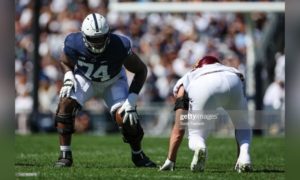It is with little anticipation for surprise that I write that the football analytics website Pro Football Focus often comes under fire for its grading system, and the manner in which they occasionally assign blame on a play. Cornerbacks tend to get the shaft if they don’t get anticipated safety help over the top, for example.
But that’s just one of the many facets of the site’s data stream, which also logs and classifies every snap of every player from every team from every game. And when gathered all in one place, it can reveal some interesting information.
PFF’s charts show, for example, that Roethlisberger utilized play action less than any other quarterback in the league, on just 11.6 percent of his passes. The league average was 21 percent.
The Steelers quarterback threw only three touchdowns compared to four interceptions while actually lowering his accuracy in the process, so the play action is certainly an area in which the offense as a whole must improve next season.
Roethlisberger’s approach was also more conservative than the average quarterback in terms of designed movement after the snap. Last year, he utilized a standard drop back 93 percent of the time, a little more than three percent above the average. Designed rollouts accounted for just 3.4 percent of his pass attempts—22 in total.
Those rollouts often came while the veteran quarterback was under center, which was a quarter of the time. His performance also suffered under center, where he threw half of his interceptions, but only eight of his 28 touchdown passes.
He was also considerably less accurate, with his completion percentage from the shotgun of 66.4 dropping to 57.8 while taking the snap from under center.
This may not come as much of a shock, but Roethlisberger’s pass attempts came inordinately often on screens, with 14.5 of his pass attempts stemming from that variety of play, compared to a league average of 9.7. In particular, his 11.1 percent of screen passes to wide receivers or tight ends was the second-highest total among all passers.
Also not much of a revelation is that Roethlisberger’s passes tended to belie his right-handedness, as his percentage of pass attempts toward the left side of the numbers ranked fifth-lowest in the league.
Despite his greater than average frequency of pass attempts on go routes, the end result was not necessarily indicative of its usage. While eight of his touchdown passes were on go routes, so were six of his interceptions, while both his completion and accuracy percentage on such passes was below average—yet another area to improve.
One route on which he did excel was targeting slant routes, which he also threw inordinately often in comparison to the league average. Such routes produced five touchdowns to one interception, and he saw a completion percentage of 73.5 percent.
Victimized by seven drops on such passes, his accuracy percentage on such throws was an impressive 87.8. Only corner routes, which are by their nature a red zone-oriented route, produced scores at a greater rate for the Steelers.
This is just a small sampling of the insights that could be gained working through this data, which, outside of accurately transcribing the plays, is free from the subjectivity that Pro Football Focus’ grading system is so often maligned for, so feel free to browse through the charts yourself.







